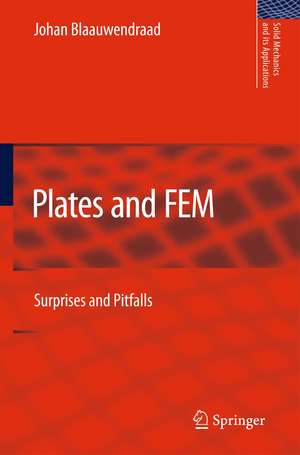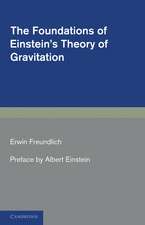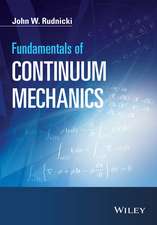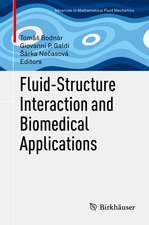Plates and FEM: Surprises and Pitfalls: Solid Mechanics and Its Applications, cartea 171
Autor Johan Blaauwendraaden Limba Engleză Paperback – 28 mai 2012
| Toate formatele și edițiile | Preț | Express |
|---|---|---|
| Paperback (1) | 590.95 lei 6-8 săpt. | |
| SPRINGER NETHERLANDS – 28 mai 2012 | 590.95 lei 6-8 săpt. | |
| Hardback (1) | 646.73 lei 6-8 săpt. | |
| SPRINGER NETHERLANDS – apr 2010 | 646.73 lei 6-8 săpt. |
Din seria Solid Mechanics and Its Applications
- 20%
 Preț: 698.10 lei
Preț: 698.10 lei - 24%
 Preț: 800.16 lei
Preț: 800.16 lei -
 Preț: 402.14 lei
Preț: 402.14 lei - 15%
 Preț: 640.06 lei
Preț: 640.06 lei - 15%
 Preț: 653.14 lei
Preț: 653.14 lei - 18%
 Preț: 1124.92 lei
Preț: 1124.92 lei - 15%
 Preț: 643.84 lei
Preț: 643.84 lei - 18%
 Preț: 1119.38 lei
Preț: 1119.38 lei - 20%
 Preț: 573.20 lei
Preț: 573.20 lei - 18%
 Preț: 1607.92 lei
Preț: 1607.92 lei - 17%
 Preț: 393.72 lei
Preț: 393.72 lei - 17%
 Preț: 459.41 lei
Preț: 459.41 lei - 18%
 Preț: 959.98 lei
Preț: 959.98 lei - 18%
 Preț: 747.71 lei
Preț: 747.71 lei -
 Preț: 388.55 lei
Preț: 388.55 lei - 18%
 Preț: 787.15 lei
Preț: 787.15 lei -
 Preț: 406.25 lei
Preț: 406.25 lei - 15%
 Preț: 639.08 lei
Preț: 639.08 lei - 24%
 Preț: 784.84 lei
Preț: 784.84 lei - 15%
 Preț: 643.34 lei
Preț: 643.34 lei - 18%
 Preț: 958.07 lei
Preț: 958.07 lei - 18%
 Preț: 1228.15 lei
Preț: 1228.15 lei - 18%
 Preț: 734.27 lei
Preț: 734.27 lei - 18%
 Preț: 1233.06 lei
Preț: 1233.06 lei - 18%
 Preț: 1236.19 lei
Preț: 1236.19 lei - 18%
 Preț: 950.96 lei
Preț: 950.96 lei - 18%
 Preț: 906.48 lei
Preț: 906.48 lei - 18%
 Preț: 964.54 lei
Preț: 964.54 lei - 20%
 Preț: 995.75 lei
Preț: 995.75 lei - 18%
 Preț: 953.65 lei
Preț: 953.65 lei - 18%
 Preț: 1239.67 lei
Preț: 1239.67 lei - 18%
 Preț: 962.35 lei
Preț: 962.35 lei - 18%
 Preț: 964.54 lei
Preț: 964.54 lei - 18%
 Preț: 913.11 lei
Preț: 913.11 lei - 18%
 Preț: 1226.90 lei
Preț: 1226.90 lei
Preț: 590.95 lei
Preț vechi: 695.24 lei
-15% Nou
Puncte Express: 886
Preț estimativ în valută:
113.09€ • 122.80$ • 94.100£
113.09€ • 122.80$ • 94.100£
Carte tipărită la comandă
Livrare economică 22 aprilie-06 mai
Preluare comenzi: 021 569.72.76
Specificații
ISBN-13: 9789400731899
ISBN-10: 9400731892
Pagini: 440
Ilustrații: XXVI, 414 p.
Dimensiuni: 155 x 235 x 23 mm
Greutate: 0.61 kg
Ediția:2010
Editura: SPRINGER NETHERLANDS
Colecția Springer
Seria Solid Mechanics and Its Applications
Locul publicării:Dordrecht, Netherlands
ISBN-10: 9400731892
Pagini: 440
Ilustrații: XXVI, 414 p.
Dimensiuni: 155 x 235 x 23 mm
Greutate: 0.61 kg
Ediția:2010
Editura: SPRINGER NETHERLANDS
Colecția Springer
Seria Solid Mechanics and Its Applications
Locul publicării:Dordrecht, Netherlands
Public țintă
GraduateCuprins
Theory of Plates.- Plate Membrane Theory.- Applications of the Plate Membrane Theory.- Thick Plates in Bending and Shear.- Thin Plates in Bending.- Rectangular Plate Examples.- Circular Membrane Plates.- Circular Thin Plates in Bending.- Didactical Discrete Models.- Discrete Model for Membrane Analysis.- Discrete Model for Plate Bending.- FE-Based Design in Daily Practice.- FEM Essentials.- Handling Membrane FEM Results.- Understanding FEM Plate Bending.- FE Analysis for Different Supports.- Handling Peak Moments.- Sense and Nonsense of Mindlin.- Reinforcement Design Using Linear Analysis.- Special Slab Systems.- Special Topics and Trends.- Case History of Cable-Stayed Wide-Box Bridge.- Shape Orthotropy.- Shape-Orthotropic Membrane Rigidities.- Orthotropic Plates in Bending and Shear.
Textul de pe ultima copertă
This textbook aims to be the bridge between plate theory and FE-software.
Structural engineers must translate elastic analysis results into economic structure dimensions and reinforcement, which raises difficulties. Not all engineers are well enough equipped for the increasingly easy-to-use powerful programs. The problem is not lack of FE-knowledge, but rather ignorance of plate behaviour. Therefore, this book starts with classical plate theory for membrane and bending states, and proceeds to FE-practice.
This volume can be used for university courses, serving as practical preparation for the engineering profession, and as a guide to structural designers.
Structural engineers must translate elastic analysis results into economic structure dimensions and reinforcement, which raises difficulties. Not all engineers are well enough equipped for the increasingly easy-to-use powerful programs. The problem is not lack of FE-knowledge, but rather ignorance of plate behaviour. Therefore, this book starts with classical plate theory for membrane and bending states, and proceeds to FE-practice.
This volume can be used for university courses, serving as practical preparation for the engineering profession, and as a guide to structural designers.
Caracteristici
Handling stress singularities in stretched and bended plates Mesh design recommendations Understanding the difference between Kirchhoff and Mindlin plate theory Determination of shear rigidity of complex orthotropic plate cross-sections Economic reinforcement on basis of linear-elastic FEM analysis Prevention of glaring mistakes in calculating torsion rigidity of orthotropic plates Includes supplementary material: sn.pub/extras




















